OMG—Is that Once Upon a Time in China IV?
Well, yes, but that’s not what we’re here to talk about. We’ve dug up specimens of two very different types of high-tech video playback media from decades ago— and it’s much more interesting than you might guess.
LaserDiscs were a popular precursor to the DVD, with relatively high density optical storage of video, audio, and data. They were invented in 1958, and first came on the market a full twenty years later in 1978. This made them concurrent with VHS video tape and CDs. They were common even in video rental stores until the mid-1990s. They could store 30 or 60 minutes of video on each side, with a track that was 42 miles long.
A LaserDisc is 30 cm (12 inches) in diameter, and weighs about half a pound. Overall, the appearance is just that of an overgrown CD:
Both the video and audio signal were initially analog, using pulse-width modulation to encode the signal. Later versions used digital audio as well.
The popularity of LaserDiscs gradually waned (even in Japan where they were more common), and production of discs ceased around 2001, with players being made as late as 2009 in Japan.
Technological factors aside, a LaserDisc is also one hell of a rainbow making machine. Much more so than a CD, even. Out in the sun, the camera cannot quite capture the intensity of the reflected spectrum. (As we have noted before, digital cameras are designed to photograph reflective subjects, and do not have the dynamic range necessary to record intense colors properly.)
Science digression:
Back inside our shop, the “rainbows” look completely different!
Why is that? The continuous rainbows that we see outside are the result of looking at the “white” spectrum of sunlight— which contains a nearly perfect continuum of colors of light. (There are some skinny absorption lines in there, but they’re too fine to make out with this limited technology!) But when we look at the reflection and refraction of our overhead fluorescent lights in the lab, we don’t see that at all. Instead, we see distinct (albeit curved) images of fluorescent tubes in five distinctly separated colors: Red, Orange, Green, Blue, and Violet.
It turns out that what we usually see as “white” from fluorescent lights is almost the exact opposite of a real “white” spectrum. It’s actually a set of distinct colors, chosen in proportion and intensity to trick human eyes (with our red, green, and blue sensors) into perceiving the light the same way that we perceive light that comes in a continuous spectrum. (If earthlings ever receive intelligent visitors from other worlds, we could imagine wars being started over this kind of thing.)
The particular lines that are present in our fluorescent lights (the Red, Orange, Green, Blue, and Violet) result from a combination of the excitation spectrum of mercury and phosphors (e.g., europium based) that are added to produce the red elements of the spectrum. (Here’s an example spectrum for cool white fluorescent bulbs showing which elements cause each of the lines.)
Let’s take a look at our other specimen, a VideoDisc. At first glance, you might not notice that this copy of The Godfather Part II is any different than the LaserDisc that we just looked at.
However, it comes not in a paper sleeve, but in a rigid plastic case— and what exactly is the “Capacitance Electronic Disc System?”
To get the disc out, there is a spring clip to release a carrier tray. The disc inside— to first impressions —looks and feels like a standard vinyl LP record. It’s light weight, slightly flexible, and dark.
But when you take it out into the sunshine, it doesn’t look a bit like a vinyl record— it gleams like a black opal; like what could be the love child of the LP and the LaserDisc.
You might think that it would need some extremely fine patterning to make it that beautiful, and if so, you’d be right. This disk is actually a grooved vinyl platter— just like an LP —except that it has a conductive surface and a microscopic groove.
How microscopic? The groove is only 657 nm wide (comparable to the wavelength of red light; about 1/200 the width of a human hair), and can be up to 12 miles long. A titanium plated needle, riding ever so gently in that tiny groove, detects changes in capacitance as the air pressure changes between the needle and the variations in the groove in the conductive vinyl disc.
This varying capacitance in turn alters the frequency of a resonant circuit, producing an FM electrical signal which is then decoded into video and audio signals by the player’s electronics. (wikipedia)
So, it really is just a “modern” evolution of the LP. And, you can see why it comes in a rigid case. The least scratch would destroy it.
If you look closely, you’ll see some spoke-like features in the pattern on the disc. This indicates that the VideoDisc rotates at constant speed during playback.
(The lack of any regularly repeating pattern like this on our LaserDisc is a good hint that it does not follow the same scheme. Indeed, if you look closely at the LaserDisc packaging that we showed earlier, you’ll see the “CLV” mark, indicating that it spins at constant linear velocity— changing rotation speed as playback progresses.)
VideoDiscs came out in 1981, after a long 17 years in development. Players were only in production until 1984, and disc production stopped in 1986.
Not only was it late to market, but it came to be known by that name (“VideoDisc”) that was unfortunately, confusingly similar to “LaserDisc.” And so they went away, as did LaserDiscs later when DVDs became popular.
Decades later, the VideoDisc is far more obsolete than even a LaserDisc.
But it remains a remarkably beautiful piece of technology.




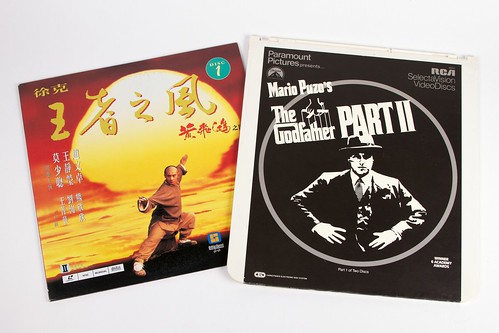



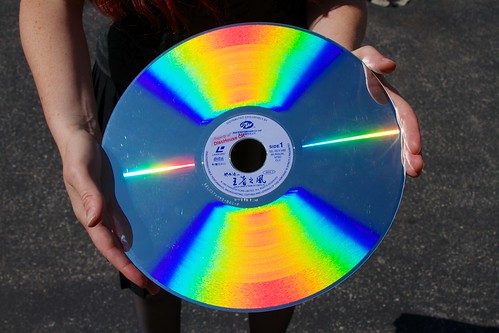
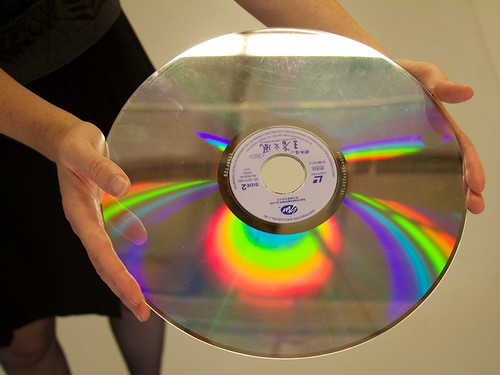
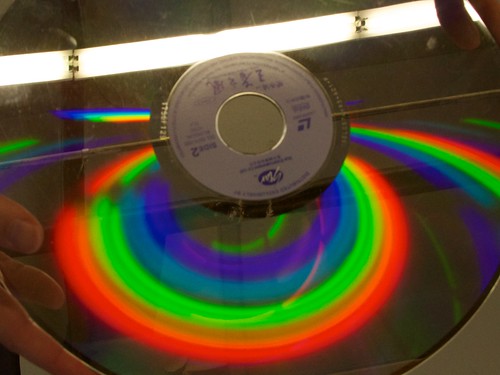


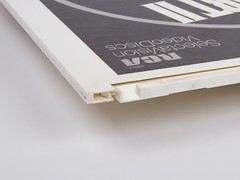

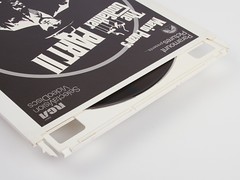
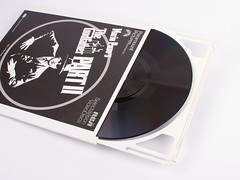

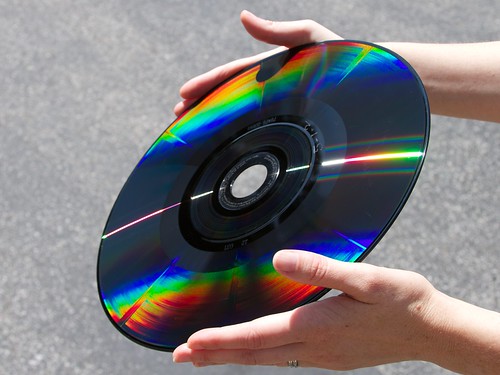
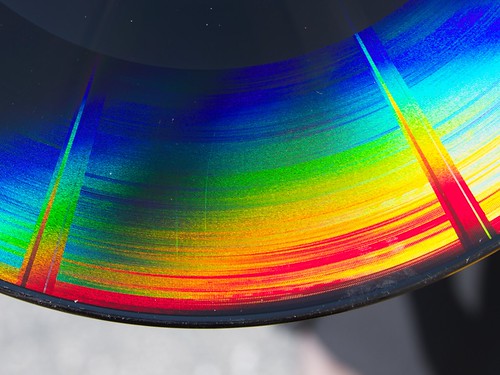

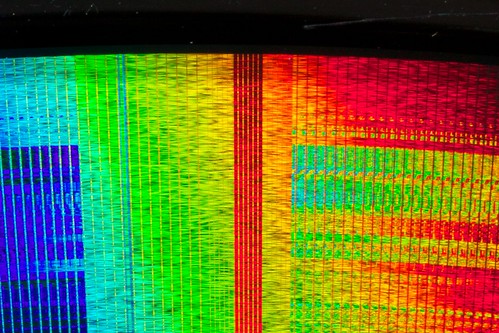
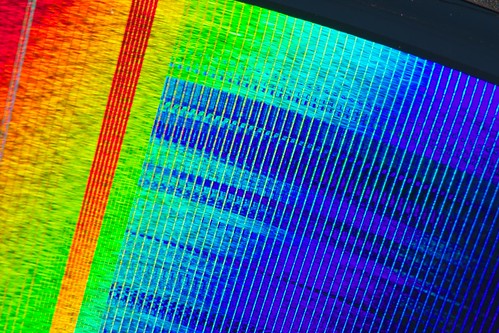
I don’t believe I’ve ever actually watched a LaserDisc, but as a child I remember seeing their packaging in HMV. Of note was Apocalypse Now – looking utterly terrifying in its huge, LP-sized sleeve with an evocative sunset and scrawled title. Now that is a film, I thought.
I teach science. In some supply closet I found a bunch of diffraction gratings mounted in cardboard tubes. There is a slit at one end. My students have had great fun looking at the various spectra from the classroom lighting, and the reflection of the sunlight on a white piece of paper. We usually spend a whole day looking at various light sources (lamps, lasers, etc) and talking about why the spectra look the way they do. It’s a great introduction to color and a whole number of related topics. The next time I do this, I’ll have to try a CD as well.
There’s a project out there for making a spectrometer using a CD/DVD as the “diffraction grating” ( http://www.instructables.com/id/Naff-Movie-into–DVD-Spectra-/ )
(actually, there appear to be quite a LOT of such projects, of varying degrees of complexity and actual measurement ability.)
That’s pretty cool, I’ll have to try it out.
I have some old laser disks from the Architecture Machine Group, the precursor to the MIT Media Lab. They used laser disk players in a number of their projects. Each track was 200 nm wide and each disk had about 50,000 tracks with about a 10cm playable range. Each track stored a video frame, so if it was easy to do stop motion and variable speed forward and backward motion by just stopping the seek head or moving it forward or backward at the desired rate.
One project was a photo archive. One graduate student actually digitized maybe 10,000 slides from MIT’s Roche slide library and produced the relevant meta-data to provide an image search utility. (The data has been lost as best I can tell.) There was also the Aspen project which implemented something like Google Street View complete with store interiors, menus and so on. You could drive down a street, turn at the corner, go into a store, stop, back up, and even change seasons. They built a four camera rig and drove all over town. By using two laser disk players, the system could dynamically edit the video so you had a continuous ride around town. (I have the disk for this, but not the meta-data.)
I don’t remember ever watching any movies on the lab players, though there was an English and Japanese language episode of Columbo we used in demos. NASA’s JPL produced a couple of laser disks with data from the early 1980s planetary flyby. Of course, resolution is limited, but they crammed on a lot of pictures.
I actually have an old laser disk player I’ve used for digitizing some of the historical disks I own. Does anyone want some late 70s footage of downtown Aspen? It has an original helium neon laser. (The Hughes tech pronounced it “hee-knee”, and I think he considered it a swear word.)
The diffraction pattern was hard to miss, but ours was a generation weaned on Edmunds Scientific which sold a variety of diffraction gratings for both serious use and for decoration and jewelry. Diffraction grating pins were sort of the LED pins of the 1960s. There was a reason they were called the go-go years.
I’ve owned players for BOTH systems. I originally bought the RCA video disk player when they were making a big market push pricing the disks and players at well below the cost of the Laser disks. When RCA gave up on the product (they committed to produce new disks for a year or two after the players were discontinued) prices on Laser disk players and disks had started to drop. So I bought a high end Sony LD machine that could also play CD’s. It had a frame buffer memory that enabled it to still frame and even slow play CLV disks too. I still have some of the laser disks and I bought a used basic player on ebay after the Sony died (a mechanical problem, and no spare parts were available). The RCA video disk system’s biggest problem was that the disks had a limited number of plays before they’d wear out. Early Laser Disks suffered from an adhesive failure that would render the disks unplayable (“laser rot”). Multi layer DVD’s don’t seem to have the same issue, maybe because they are smaller.
A friend of mine in high school owned an LD player that simultaneously impressed me and annoyed me. As a budding animator he bought many Disney movies which contained alternate video tracks showing sketches and key frames while the movie’s audio continued as normal. The downside was that one of us had to get up to flip or swap discs every 45 minutes.
I was in college during the transition to DVDs which was easy for people tired of rewinding VHS tapes, but for another friend who held onto his LDs too dearly, rather than buying a new DVD player for around $400 he decided to spend over $1000 for one that also played LDs.
Where do VideoCDs fit into this picture? The mpeg-1 CDs that fit about an hour per disc and gained much popularity in Asia. I guess that may have been getting too digital…
Insert obligatory 1980’s video-parlor Dragon’s Lair reference here – – the first commercial video game which utilized a Laser Video Disk to provide a variable-path decision tree storyline & background for the game.
http://en.wikipedia.org/wiki/Dragon%27s_Lair
The beautiful pattern you see on the disc is the NTSC video waveform encapsulated in the aluminum. The six closely-spaced bars are the vertical sync pulse serrations. You can see them with an oscilloscope if you look at an analog TV camera output at about 200 microseconds per division.